
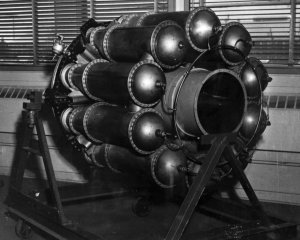
(more about this particular engine)
Frank Whittle's W2B Turbojet:
United Kingdom versus United States Development
by T L Jones
AEHS Legacy Member, Aero Engines Carlisle, UK (www.aeroenginescarlisle.org.uk)
Published 13 Jul 2013; Revised 18 Nov 2021
 |
 |
| Rolls-Royce Welland (AEC) (more about this particular engine) |
General Electric I-16 (NARA) |
It is interesting to compare the significant differences between the development of the Rolls-Royce RB23 Welland and the General Electric (GE) I-16 (J31), both of which were based on Frank Whittle's original W2B design of 1940. The relationship between the Rover Company (Rover), who were responsible for the development of the W2B in the UK, and Whittle appears to have been quite different to the relationship that GE had with Whittle in the US. The practices of the air forces of the two countries were also different.
In the UK it was normal practice for the government to finance aero engine development for the Royal Air Force through the Air Ministry, a task taken over by a newly created Ministry of Aircraft Production (MAP) in mid 1940. The UK government had been supporting Whittle in the development of a series of experimental jet engines, albeit quite modestly in the beginning, since the setting up of the Power Jets company, by Whittle in 1935. In late 1939 Power Jets were given a contract to design and develop a production engine, which was designated the W2. The initial contract to Rover to develop and produce the W2 engine was placed by the Air Ministry in 1940. This arrangement where both organisations were necessarily involved in the development of the design inevitably led to conflict, particularly as Whittle was a determined fellow working under great stress. Indeed, had Whittle not been a determined fellow the whole British jet engine project would not have taken place until years later, if ever! The necessity to involve two organisations in the development and production of the W2 arose because Power Jets did not have the capacity, skills and experience to design, develop and produce the engine.
Sir Henry Tizard, the Ministry of Aircraft Production’s principal scientific adviser who championed Whittle's cause, wrote in 1940 [1] that the development of the jet engine was “a first class gamble”; that “enthusiastic inventors are often extremely difficult to deal with”; and he expected that Rovers “will produce engines, these will represent the views of Rovers rather than of Power Jets”; that “we shall not get progress with BTH” who were contracted by Power Jets to build prototype engines. All of this was true and came about. Tizard was anxious to have a number of engines built by the Vauxhaul “strictly to Power Jet's designs”, a proposal that was pursued but came to nothing as other wartime priorities intervened.
Problems arose in May 1940 when Whittle realised that there were flaws in the design of the W2. He prepared a revised design designated the W2B, but the aerodynamic design and the general arrangement of the engine was not given to Rover until early [2] 1941 [3]. Rover then had to prepare the detailed production design. It is therefore not surprising that when GE became involved in late 1941 it was found that “some of the drawings were incomplete” [4]. A further difficulty that Rover faced was that it had few facilities that were not obvious targets for air attack, and suitable for the development and later production of an entirely new type of aero engine. The traditional aero engine manufacturers could not be involved at this time [5] because they were fully engaged in developing and building conventional engines at a time when Britain stood alone against Germany. Despite these difficulties, by the middle of 1941 Rover had opened new facilities in Clitheroe and Barnoldswick in rural North West England that enabled them to make a serious start on the project.
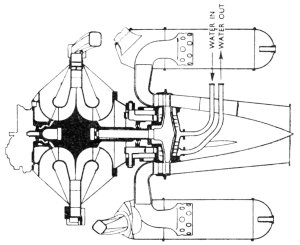 |
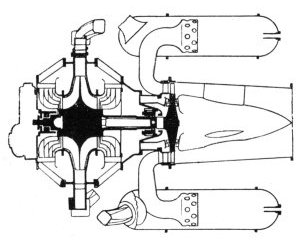 |
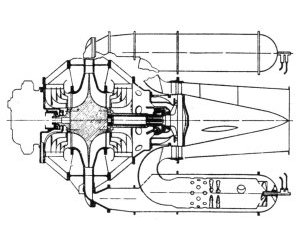 |
| Whittle W1 (AEHS) | Whittle W1A (AEHS) | Whittle W2B (AEHS) |
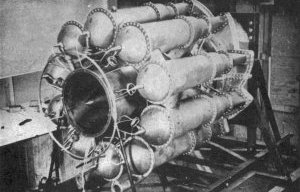 |
 |
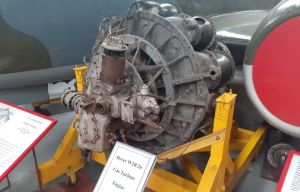 |
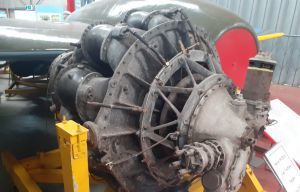 |
| Whittle W2 (AEHS) | Whittle W2B (AEHS) | Straight Through Rover W2B/26 at the Midland Air Museum near Coventry. (John Northall) | |
Rover's first development engine was delivered to Power Jets in April 1941 and the second development engine was run in Clitheroe in November 1941. Many of the staff employed by Rover in the new facilities were very young and inexperienced. In one case a young lady just seventeen years old was employed as an inspector in the main build section of the factory, whilst Adrian Lombard, who went on to become Rolls-Royce's Chief Engineer and the designer of engines upon which Rolls-Royce's commercial success still depends (the RB211) was in his mid twenties. Rover were also having to rely on others for the design and or production of parts of the engine. For example Rover sub-contracted the development of the combustion system to Joseph Lucas Ltd, who developed the “colander” design of flame tube in March 1942. In addition Rover, along with Power Jets and others, had to carry out experiments to discover which materials would be most suitable for the components of the engine. Amongst the development problems were “surging” of the engine, the development of efficient combustion chambers, and the development of materials for combustion chambers and turbine buckets.
The problems faced by Rover were an order of magnitude greater than those faced by Ford (UK) and Packard (US) when putting the Rolls-Royce Merlin engine into production. Ford and Packard undertook large scale production an existing, fully designed, documented, tested and operational engine. Rover had to undertake the development a completely new type of engine whose design was premature and incomplete! Rover incorporated their B23 compressor case and designated the resulting engine W2B23. By the time Rolls-Royce were in a position to take over responsibility for the production of the W2B23 in April 1943, the design and development of the W2B was virtually complete and the staff, machinery and factory were ready. What Rolls-Royce brought to the programme were the skills and leadership to produce the engine to a consistent standard in the numbers and on the time scale needed. Rolls-Royce initially named the engine the B23, but were later asked to add the R in order to avoid confusion with US bomber aircraft. At about this time Rolls-Royce also named the engine Welland after a river that flowed through the English county where Frank Whittle had designed the engine; so it became the RB23 Welland.
Many writers [6, 7, 8, 9, 10, 11] have criticised Rover for being slow in developing the W2B. I suggest that what Rover achieved in the three years between 1940 and the beginning of 1943 is quite outstanding, and bears comparison with any other organisation tasked with developing a new conventional aero engine let alone a very unconventional one. Rover were led by the Wilks brothers, Spencer and Maurice — Managing Director and Chief Engineer respectively, whose experience was in the making of motor cars not aero engines and many of whose staff were conscripted to work in their new factories under government wartime regulations. It is disappointing that so few [12, 13] have given Rover credit for the work they did on the early development of jet propulsion. When Rover and the Wilks brothers were being criticised after WWII they were busy designing, developing and putting into production the Land Rover off road vehicle, which owes much to the Jeep, and which is still in production today.
Rover were greatly assisted in solving the problems of developing the W2B by Power Jets and the other members of the UK government and industry whom the MAP had encouraged to become involved in jet engine production and development. The UK government were so convinced (by Sir Henry Tizard) of the importance of Whittle's invention that in 1940 they gave financial encouragement to a number of British companies to develop alternative engine designs. Of particular significance to this discussion is the involvement of Frank Halford, who designed the successful H1 Goblin engine based on Whittle's ideas but with a single sided compressor and a straight through layout. Goblin engines, which powered the prototype Lockeed P-80 Shooting Star, are still flying today. Most of the British companies involved developed successful engines leading to a “cornucopia of designs” [14] by the end of WWII.
 |
| de Havilland Goblin (NARA) |
Another early British gas turbine developer was Metropolitan-Vickers, later Metrovick, which developed the axial-flow Beryl during WWII. The project was passed along to Armstrong Siddeley, which develped a neat little axial-flow ~1,500 shp turboshaft called the Mamba, used in the Armstrong Whitworth Apollo airliner, among others. A further development was the 3,000 - 4,000 shp Double Mamba, used in the Fairey Gannet anti-submarine warfare aircraft. Armstrong Siddeley also scaled up the Beryl to become the highly successful Sapphire.
 |
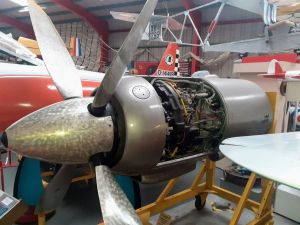 |
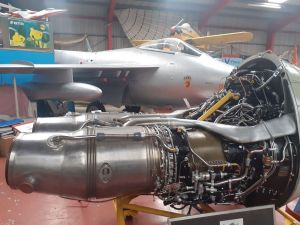 |
| Armstrong Siddeley Mamba (John Northall) | Armstrong Siddeley Double Mamba (John Northall) | |
Coordination of developments in the UK was carried out through a Gas Turbine Collaboration Committee (GTCC) that was set up on the initiative of MAP at the end of 1941 following disclosure of the design of the W2B to GE. Ernest Hives, the general manager of Rolls-Royce, is quoted [15] as having said in September 1941 that, “as we were giving so much information to America we might at least give it to one another”. Membership of the GTCC included all those private companies involved in jet engine manufacture as well as the national laboratories.
Whilst GE were not members of the GTCC there was considerable trans-Atlantic cooperation, particularly on turbine blade materials, along with compressor and turbine manufacture. Regular GE progress reports were submitted to the GTCC, and special reports were made following visits of UK personnel to the US. Copies of the GTCC minutes and reports produced by committee members were sent to the US. The committee was also aware from intelligence reports that work was being done in Germany in developing jet propulsion technology. Materials developed under the auspices of GTCC include Nimonic 75 and 80 alloys, used for the flame tubes and turbine blades, and Jessops G18B steel for turbine discs. The barometric controller and overspeed regulating fuel pump for the engine management system were developed by Harry Ricardo and the Joseph Lucas Company, all GTCC members.
Such widespread collaboration in the development of the W2B engine in the US could not have taken place, even if the US Army and Navy had wished, because of the conditions of secrecy demanded by the UK of GE.
The US, stimulated by Whittle's early success, entered into the jet engine project with enthusiasm. A committee appointed by the National Advisory Committee for Aeronautics (NACA) recommended that in addition to the Whittle engine, the three engine projects being pursued by Westinghouse, Allis Chalmers and GE in the US should also be developed [16]. The GE project, the TG-180, was subsequently developed into the very successful J35 in 1946. The enthusiasm was such that contracts for the production of large numbers of I-16 (J31), and an uprated version, the I-20, were overtaken by the development of the significantly more powerful I-40 (J33) engine and contracts had to be cancelled and a negotiated settlement reached in 1946 [17].
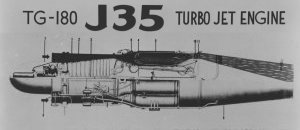 |
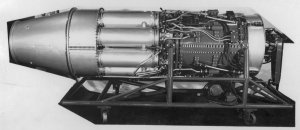 |
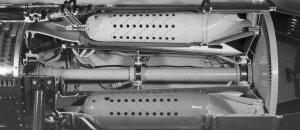 |
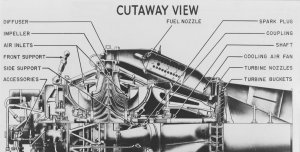 |
| General Electric J35 (NARA) | General Electric J35 (NARA) | J35 Combustion Chamber (NARA) | General Electric J33 (NARA) |
Nimonic alloy turbine blades, which were critical to the success of the engine, were not available until May 1942. The first batch was made by GE from material supplied by the UK, which gives some indication of the close transatlantic cooperation that existed. Difficulties experienced during the development of the engine included, most critically “surging”, but also bearing failures and combustion chamber splitting. There was also difficulty in achieving the designed thrust, which was finally overcome by skewing the turbine blades by 5°, a particular contribution of Whittle, which was adopted by Rover in March 1943, almost two years after it was first proposed. Had Rover recognised the significance of this modification, amongst a host of others proposed by Power Jets, earlier then much of the despondency in MAP at the end of 1942 may have been avoided. The skewing of the turbine blades was the last major design change in the development of W2B23, although the design was not “frozen” until July 1944.
At the time that design information and an experimental engine were provided to GE (October 1941), many of the design details had not been finalised. Whilst the aerodynamic design is identical and many of the mechanical features of GE's first engine (the I-A) are the same as the Rover W2B23, there are major differences, particularly in the design of the wheelcase, which was redesigned to reflect the US practice of mounting the engine ancillaries on the engine itself rather than on a remote gearbox, as was the British practice.
Subsequent development of the GE I-14 and I-16 engines was dominated by Whittle's and GE's own ideas and is less influenced by the other British players. Whittle provided GE with details of the W2/500, his development of the W2B, during a visit to the US in 1942.
GE might have benefited from a significant development made in 1942 that, which was the boring of a hole through the centre of the impeller. This providing a degree of stress relief and allowed the turbine and compressor shafts to be coupled together as the assembly of the engine progressed, rather than being one of the first operations. This design change also allowed the turbine to be replaced simply by removing the wheelcase rather than having to completely dismantle the engine.
The second and most significant change that Rover made, caused by the difficulty of fabricating the combustion chamber assembly and perhaps stimulated by Halford's H1 Goblin engine, was to build the engine as a straight through design, which it designated the W2B26. This design was based on the major components and aerodynamic design of the W2B, as required by the contractual arrangements with the MAP, which forbade any deviation from the aerodynamic design. This engine layout greatly simplified combustion chamber fabrication and assembly. The W2B combustion chamber was manufactured from Inconel, a difficult to work austenitic nickel chrome alloy that had to be formed into curved double-walled tubes turning through 180°, and at the same time changing from a round to a smaller square cross section. Each of the ten combustion chambers was built in four pieces, and held together by a total of 1,800 small nuts and bolts, that had to be lock-wired. At that time it was not appreciated that jets, unlike piston engines, do not shake themselves apart!
The reversed flow design of the W2B is a good example of a designer passing on a design problem to the production engineer! The revised layout also gave a smoother airflow path through the engine. The “straight through” layout was subsequently almost universally adopted for centrifugal compressor turbojet engines. Rover discretely commenced the design of the W2B26 in the autumn of 1941 at about the time that information was first being passed to GE. Discretion was necessary because of the difficulties in the relationship between Whittle and Rover and differences of opinion within MAP. The engine first ran in March 1942 and when Rolls-Royce took over the engine project from Rover it was the W2B26 that they chose to develop, as the RB37 Derwent rather than the W2/500 as Whittle had wished. Rolls-Royce went on to build 335 RB37 Derwent engines before the end of the war.
One of the major design changes introduced in the W2/500 design was the adoption of a larger diameter turbine with a smaller number of blades; the same size compressor was used. This change was suggested by the Royal Aircraft Establishment (RAE) and was subsequently adopted by GE in the I-16 [18] and Rolls-Royce in the RB37 Derwent.
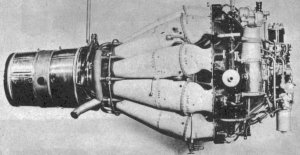 |
| Rolls-Royce Derwent (AEHS) |
Other concepts that are common to Whittle's later engines and the I-16 include a revised compressor housing, and heat shields between the combustion chamber discharge ducts and the rear compressor inlet. The revised compressor housing had longer cast diffuser vanes terminating in right angled bends, the bends having guide vanes. It is not clear whether the design of the revised compressor housing, known in the UK as the Type 16, originated in the UK or in the US. Whittle was experimenting with a compressor housing with right angle bends and guide vanes, but with a circular diffuser fabricated from sheet metal, in the middle of 1941 [19]. What appears clear is that the use of vanes to guide gas around sharp bends did originate at GE with the work of Wirt [20] in the mid 1920s.
Not having to stick to Whittle's aerodynamic design (as Rover had to do) gave GE an advantage. Nonetheless, like Rover, GE had significant problems in producing the reverse flow engine to time and specification [21], which, as in Rover's case, delayed the production schedule and allowed the straight through I-40 time to dominate. In addition a significant amount of GE's development capacity was distracted by the US Navy's requirement for a gasoline fuelled I-16 to power the unsuccessful Ryan FR-1 Fireball carrier aircraft.
In producing the I-16 in significant numbers, GE did what Whittle wanted Rolls-Royce to do — put the W2/500 into production.
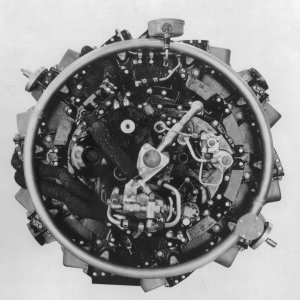 |
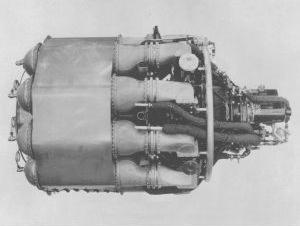 |
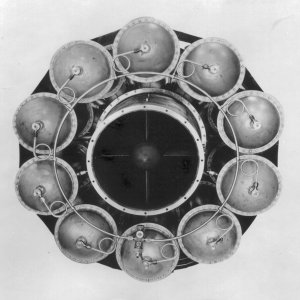 |
| General Electric I-16-3 (AFHRA) | General Electric I-16-3 (AFHRA) | General Electric I-16-3 (AFHRA) |
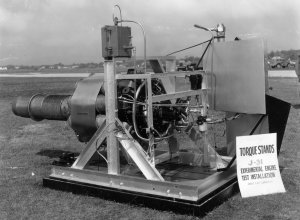 |
 |
| General Electric J31 (NMUSAF) | General Electric J31 (NMUSAF) |
What is most interesting is that the thrust (the prime performance indicator) of both production engines (the I-16 and the RB23 Welland) is the same at 1,600 lb [22, 23].
From a UK perspective, it is also interesting that the Derwent, which incorporated just one of the W2/500 innovations (the larger turbine) had a thrust of 2,000 lb. This surely vindicates Rover's controversial decision to proceed with the straight through concept in the autumn of 1941 and mitigates their failure to appreciate the significance of the introduction of a 5° twist to the turbine blades earlier.
Had Whittle developed the “straight through” concept rather than the W2/500 then a 2,000 lb thrust engine might have been available earlier. Had this been the case, both the RAF's RB23 Welland-engined Gloster Meteor 1 and the US Army's I-16-engined Bell P-59 Airacomet would have been better aeroplanes. Whittle had designed straight through engines (the W2Y and W3X) [24], and it is difficult to understand why he persisted with the reversed flow concept beyond the W2B, particularly as he had a contract from MAP to develop the W2Y.
What can also be seen is that the B of Rolls-Royce's RB engine designation scheme starting with RB23, and still used today, has its origins in the early work undertaken by Rover and is a silent reminder of Rover's contribution to the development of the jet engine between 1940 and 1943.
The contribution of David Brooks, R-RHT, to the preparation of this article is acknowledged.
References
1. Tizard, Sir Henry AVIA15/1324 in the National Archive, Kew.
2. Schlaifer, Robert. Development of Aircraft Engines. Harvard University, 1950, p358.
3. General Arrangement Drawing dated May 1941 AIR 62/64 in the UK National Archive Kew.
4. Stauffer, Don. “Early American Turbojets”. Torque Meter Vol. 7, No. 1. AEHS Winter 2008.
5. Schlaifer, Robert. Development of Aircraft Engines. Harvard University, 1950, p462.
6. Whittle, Sir Frank. Jet. Frederic Muller Ltd, 1953.
7. Gunston, Bill. World Enclopaedia of Aero Engines. Patrick Stephens Ltd, 1985.
8. Gunston ,Bill. The Development of Jet and Turbine Aero Engines. Patrick Stephens Ltd, 1995.
9. Golley, John. Whittle, the True Story. Airlife, 1987.
10. Kay, Antony L. Turbojet: History and development 1930-1960, Volume 1. The Crowood Press, 2007.
11 .Jones,Glyn. The Jet Pioneers, the Birth of Jet Powered Flight. Methuen ,1989.
12. Nahum, Andrew. Frank Whittle: Invention of the Jet. Icon Books, 2004.
13. Schlaifer, Robert. Development of Aircraft Engines. Harvard University, 1950.
14. Stauffer, Don. “Early American Turbojets”. Torque Meter Vol. 7, No. 1. AEHS Winter 2008.
15. Roxbee, Cox Harold. Minute in file AVIA13/947 UK National Archive Kew.
16. Case History of the Whittle Engine. Report Compiled by the Historical Office, Air Technical Services Command, Wright Field. October 1944.
17. Supplement to Case History of the Whittle Engine. Report Compiled by the Historical Office, Air Material Command, Wright Patterson Air Force Base. July 1949.
18. Handbook of Overhaul and Service Instructions, Type I-16. GE Schenectady, 1944, p 341.
19. Photograph dated 16 May 1941 in file Air 62/30 in the UK National Archive Kew.
20. Wirt L. “New Data for the Design of Elbows in Duct Systems”. GE Review Vol. 30 No. 6, June 1927, p286.
21. Supplement to Case History of the Whittle Engine. Report Compiled by the Historical Office, Air Material Command, Wright Patterson Air Force Base. July 1949.
22. Welland Mk I Aero-engine. Air Publication 4039A. UK Air Ministry, 1945.
23. Carpenter, David M. “Flame Powered”. Jet Pioneers of America, 1992
24. Brooks, David. Vikings at Waterloo. R-RHT Historical Series No 22, 1997, p54.